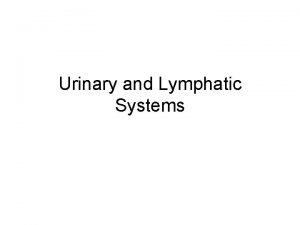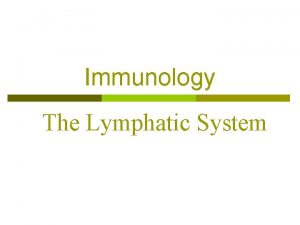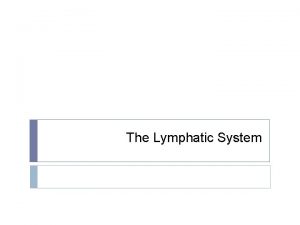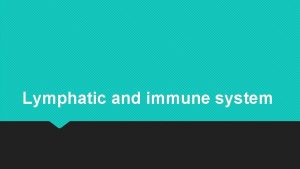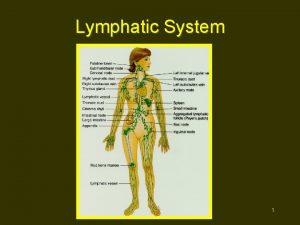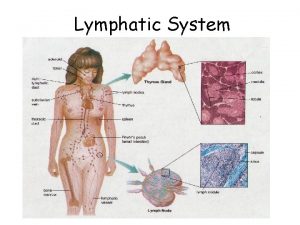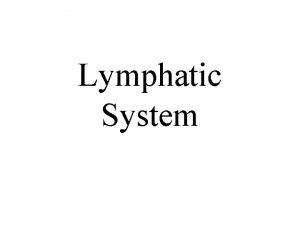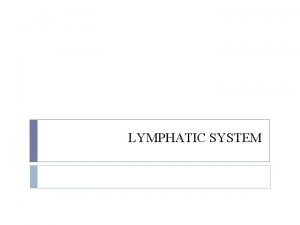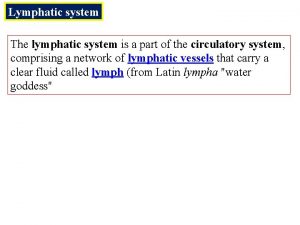Lymphatic System Fluid Movement Purpose of the Lymphatic


















- Slides: 18

Lymphatic System Fluid Movement


Purpose of the Lymphatic System 1) Takes excess tissue fluids and returns it to blood stream (fluid homeostasis) 2) Checks the fluids for infection → to alert immune system if necessary

Parts of the Lymphatic System 1. Lymph - watery fluid flowing through lymphatic system a. Mostly blood plasma from capillaries/tissue exchange (some absorbed back by capillaries - the rest lymphatic system picks up) 2. Lymph Nodes - checkpoints along the lymph system 3. Lymphatic capillaries - surround capillaries and take up remaining fluid (20 L of blood go through capillaries each day - 3 L of fluid picked up becomes lymph)

Parts cont’d 4. Lymphatic vessels - lymph capillaries join with lymph vessels and drain into subclavian vein (left shoulder) and internal jugular vein (right side of neck) - Valves prevent backflow - Lymph moves with muscle contraction - Low pressure

Why do you need to return the fluid back to your blood? 1. Blood volume would drop → drop in blood pressure if not returned 2. Blockages in lymph can cause swelling in limbs and constrict other blood vessels (edema)


Immune System Lymphocytes in Lymph nodes ‘check’ fluid for ‘invaders’ (bacteria/virus) & signal macrophages (to eat/attack) or alert general immune system (whole body response) If your lymph nodes detect ‘invasion’ they can become inflamed (tonsilitis, swollen neck - you can feel them!)

Innate Immune Response (1 st defense) Involves barricades like skin, mucous membranes, and cells that can ‘eat’ and ‘attack’ such as phagocytes and attack cells. Retrieved from

Some signs of innate response 1. Fever 2. Chemical signals 3. Inflammation Phagocytes will ‘eat’ invaders (many types like neutrophils, macrophage, natural killer cells

The cell ‘soldiers’ Neutrophils - ingest invader cell and then die afterwards (apoptosis) → see this as puss Macrophages - eat foreign cells, but do not apoptose. They expel pieces of the invader which are used as markers to help identify future invasions Natural Killer Cells (NKC’s) - can kill your own cells that are invaded by virus/cancerous

How does your body know WHERE to fight? Example: You scrape your knee and mast cells release histamine which signals inflammation response (redness, swelling, pain, heat). It also makes capillaries ‘leaky’ so phagocytes and clotting proteins can get to area quickly *Allergic reactions are inflammation responses to ‘destroy’ invading allergen. But your body has over reacted on the response and releases excessive histamine. (you take antihistamines to stop it)

Adaptive (specific) Immune Response - ‘Recognizes’ the invader because it has encountered it before. It is able to send out the correct amount of immune cells to destroy as quickly as possible before you get too sick - Slower response than innate (this is how the flu shot, measles vaccine,

Retrieved from amoeba sisters


B-Lymphocyte - - substance they recognize, they multiply to build ‘army’ of cells with Have receptors (membrane- same antibodies bound antibodies) attached to surface to recognize antigens - cells and foreign) Also produce free antibodies which ‘search’ & attach to ‘invader’ for on surface of cells (ability to determine between your own Once they encounter foreign - death The surviving cells become memory cells to make the response faster the 2 nd time *this is why vaccines work

Why do you have to get the flu shot every year, but not vaccines like measels/mumps?

Where/how can babies receive temporary immunity ?
 Lympathic
Lympathic Lymphatic system organs and functions
Lymphatic system organs and functions Synovial membrane
Synovial membrane P1-p2
P1-p2 Fluid statics deals with fluid at rest
Fluid statics deals with fluid at rest Body fluid compartments
Body fluid compartments How does water go through your body
How does water go through your body Interstitial fluid vs extracellular fluid
Interstitial fluid vs extracellular fluid Boundary layer theory
Boundary layer theory Movement of body fluids
Movement of body fluids Saag ascites
Saag ascites Light gun signals
Light gun signals Axial definition in dance
Axial definition in dance Structures piercing cribriform fascia
Structures piercing cribriform fascia What are the function of lymphatic system
What are the function of lymphatic system Chapter 12 the lymphatic system and body defenses
Chapter 12 the lymphatic system and body defenses Functions of the lymphatic system
Functions of the lymphatic system Totally tubular dude
Totally tubular dude Largest lymphoid organ
Largest lymphoid organ














